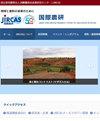青贮玉米(Zea Mays L.)和意大利黑麦草(Lolium Multiflorum Lam.)放射性铯的含量福岛第一核电站事故后三种不同耕作方法的栽培
IF 0.5
4区 农林科学
Q4 AGRICULTURE, MULTIDISCIPLINARY
引用次数: 0
摘要
整个作物青贮玉米和意大利黑麦草在夏季和冬季在福岛第一核电站事故造成的放射性核素沉降物污染的田地中种植,采用三种不同的耕作处理:浅耕处理(旋耕机耕深约10厘米),常规耕作处理(用普通犁犁耕深约20厘米,用旋耕机耙深约15厘米)和深耕处理(用犁犁耕深约35厘米,用旋耕机耙深约15厘米)。比较了不同耕作方式下0 cm ~ 10 cm、10 cm ~ 20 cm、20 cm ~ 30 cm土层放射性铯(Cs)的垂直分布和草料样品放射性铯的含量,以及各土层的土壤化学性质。土壤表层(0 cm-10 cm)的放射性铯在10 cm-20 cm和20 cm-30 cm土层因常规耕作和深耕而向深层迁移。不同耕作方式下,草料中放射性铯浓度和土壤向植物的放射性铯转移因子均无显著差异。此外,两种植物的放射性铯浓度及其tf均相对较低。这些结果表明,即使在浅耕处理下,混合土壤也能减少放射性铯的转移。此外,试验田各土层土壤交换性k2o含量均高于0.32 g/kg DW,这种高交换性k2o含量可能是两种树种对放射性Cs的吸收在所有耕作处理中均受到显著限制的另一个主要原因。本文章由计算机程序翻译,如有差异,请以英文原文为准。
Radioactive Cesium Concentration in Silage Corn (Zea Mays L.) and Italian Ryegrass (Lolium Multiflorum Lam.) Cultivated with Three Different Tillage Methods after the Fukushima Daiichi Nuclear Power Plant Accident
Whole-crop silage corn and Italian ryegrass were cultivated during summer and winter in fields contaminated by radionuclide fallout caused by the Fukushima Daiichi Nuclear Power Plant accident, with three different tillage treatments: shallow tillage treatment (tilled with a rotary tiller to a depth of about 10 cm), conventional tillage treatment (plowed with a normal moldboard plow to a depth of about 20 cm and harrowed with a rotary tiller to a depth of about 15 cm), and deep tillage treatment (plowed with a moldboard plow to a depth of about 35 cm and harrowed with a rotary tiller to a depth of about 15 cm). Vertical distribution of radioactive cesium (Cs) in the soil layers of 0 cm-10 cm, 10 cm-20 cm, and 20 cm-30 cm, and concentrations of radioactive Cs in forage samples were compared among the tillage treatments, as well as the soil chemical properties of those soil layers. Radioactive Cs in the soil surface layer (0 cm-10 cm) moved into the deeper layers at 10 cm-20 cm and 20 cm-30 cm due to plowing in the conventional and deep tillage treatments. However, significant differences were not observed for both species, either in the radioactive Cs concentration in forage samples or the radioactive Cs transfer factor from soil to plants among the tillage treatments. Moreover, the radioactive Cs concentrations in those plants and their TFs were relatively low for both species. These results suggest that radioactive Cs transfer was reduced by mixing the surface soil, even in the shallow tillage treatment. Furthermore, the exchangeable K 2 O content of soil was higher than 0.32 g/kg DW in all soil layers of the experimental fields, and such high content of exchangeable K 2 O in the soil was apparently another major reason why radioactive Cs uptake by both species was significantly restricted in all tillage treatments.
求助全文
通过发布文献求助,成功后即可免费获取论文全文。
去求助
来源期刊
CiteScore
1.00
自引率
25.00%
发文量
42
审稿时长
>36 weeks
期刊介绍:
The Japan Agricultural Research Quarterly (JARQ) is a publication of the Japan International Research Center for Agricultural Sciences (JIRCAS), which provides readers overseas with the latest information on key achievements and developments in agricultural research in Japan, with the expectation that this information would contribute to the agricultural development of countries in tropical and subtropical regions.

 求助内容:
求助内容: 应助结果提醒方式:
应助结果提醒方式:


